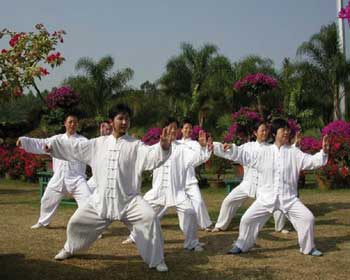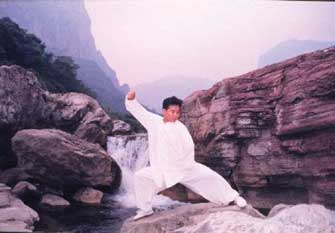| Try some Tai Chi |
| http://www.sina.com.cn 2004/04/26 13:54 中国周刊 |
You could probably count on two hands the number of times that I've seen the sun come up. It is so foreign to me that when I heard from expats in China that one of the best local sights had to be viewed just after sunrise, I really felt that whatever it was had to be truly spectacular or else I'd give it a miss. But when I was assured that this would be like coming to Beijing and not seeing Tiananmen Square, I gave in. Any park or open area would do, but I chose to go to Ritan Park, one of my favourite places during daylight hours. I had an inkling that watching people doing exercises in loose tunics would compare to reading the Departures screen in an airport lounge, but I was wrong and my friends were right. What I saw in dawn's early light was mesmerising.
I'd heard of Tai Chi, or Tai Ji in pinyin, but figured it was just another variety of martial art like judo or karate, with people jumping around with menacing fists, howling at an invisible moon. I was not disappointed to find that Tai Chi was a sophisticated form of choreographed movement based on qigong, a traditional medical and health practice in China that focused primarily on breathing regimen and channelled energy. What did surprise me was how serenely quiet, and smoothly fluid the motions were. Furthermore, what took my breath away was the numbers and size of the groups stepping and turning together in complete unison, in calm concentration, with placid looks that belied their total enjoyment. The whole event seemed like a dichotomy to me, alive yet gently robotic, free yet controlled, light but tight, soft and powerful, thoughtful but practised, forced but tranquil. For every movement, there is an equal and opposite reaction. Despite a lack of background in anatomy except for the contours of my own body, it was easy to see how Tai Chi could be beneficial in the maintenance of my good health. As ageing creeps up, with arthritis and osteoporosis ready to take me over at the slightest invitation, the advantages of this form of daily activity became readily obvious. Being one who took my inherited physical condition for granted, I had lately begun to experience stiffness and a benign fear of falling. Flexibility used to come naturally, along with a tendency to clumsiness, but my knee joints had started to accurately forecast rain, and dropsy had started to invade all of me. I could see immediately that balance was central to the form of Tai Chi, while steady rotation of every joint of the body, especially of the ankles and hips, had to keep things well lubricated. I dread the horrible twisting and jerking that's part and parcel of traditional Western exercise programs, but here the effortless callisthenics were also massaging the internal organs, encouraging a normal rate of blood pressure, a circulatory system that couldn't possibly be sluggish, while, at the same time, building a warm, cardiovascular workout without Jane Fonda's burn, stinky sweat or form-fitting, fashion-oriented gym wear. And what was this? I didn't see any of those ubiquitous water bottles lurking in the bushes. I knew that the brain needs new challenges to keep it active. Here was an activity that would rejuvenate the memory required to keep the sequence of moves in order, just like a figure skating program. There were enough movements and changes to maintain interest without being bored. A series of hand-held instruments, like a sword or machete, fan or feather, empowered the arm movements into different tensions and forces. Even though the legs and feet bear the weight, Tai Chi is definitely low impact. Still, because it is weight-bearing, bone growth is stimulated, connecting tissues and muscle functions are strengthened. There is no pressure or torque to cause undue stresses like a treadmill or stepping block because of the slow fluidity of motion and sustained poses. Good posture is important to the performance, but also a result. It wouldn't take long to improve the range of joint activity. It seemed like the whole body was in harmony; gravity, centrifugal and peripheral forces operated as aides instead of enemies. (The ancient Taoists referred to gravity as the "Heavenly Chi seeking the Earth") Best of all, no equipment, weights, wheels, pulleys, mechanics or technology would be needed.
In fact, Western researchers, who, along with fellow scientists are investigating herbal and holistic medicine to treat the patient rather than the symptoms, have made some exciting observations about the benefits of Tai Chi. It can serve equally as a preventative, a treatment or a maintenance therapy. For example, it was discovered that the risk of falling in a study group was reduced by 47.5 %. A study cited in the Hawaii Medical Journal asserted that Tai Chi increased breathing capacity and relieved back and neck aches in practitioners. In Vancouver, Canada, a husband was astounded when his middle-aged wife, suffering from MS and confined to a wheel-chair, decided to practice Tai Chi, regained her strength and motivation to successfully walk again against all odds. The American Journal of Physical Medicine and Rehabilitation reported on a study that found Rheumatoid Arthritis sufferers practising a specially tailored form of Tai Chi suffered no significant exacerbation of joint symptoms. This was great news, not just for RA sufferers but for all maturing baby boomers looking for a health regimen that is kind to the joints.* A recent study from the University of Miami School of Medicine found that Tai Chi provided substantial symptom reduction in students suffering from Attention Deficit and Hyperactivity Disorder (ADHD).* With further thought to the gentle and serene activity, I began to feel less stress and more relaxed. If I could experience this as a spectator it would follow that with active participation, grumpy moods should disappear and a more positive outlook might emerge, ridding life of depression or confusion, anxiety or anger and finding more vim, vigour and vitality instead. Tai Chi places great emphasis in the mind/body relationship. Information has been published that Tai Chi has been used successfully in the medical environment for recuperation after surgery, a tool in overcoming post-traumatic stress disorder, and a cross-training regimen for high-performance athletes. It assists with metabolic consistencies, improves concentration, self-confidence, and self-esteem. I feel good already. On a more personal level, Tai Chi can use 280 calories per hour, a significant measure, which together with a healthy diet could assist in my weight loss plan. The modulation of the slow and controlled deep breathing in tandem with the movement would help regulate the respiratory system, a vital support for my asthmatic condition. So, I think, starting tomorrow morning, I'll catch the bus in my pink silk pyjamas to join the rest of the early-risers for some Tai Chi in the park. Lao Tzu, who is widely regarded as the founder of Taoism, taught that, "It is the stiff old tree that snaps in the strong wind, while the blade of grass bends and lives to see another day". * This footnote is for the sake of information only: One cannot just put stuff in quotation marks in the middle of a text, without any linkage to anything else in the article. If those two paragraphs are indeed quotes, then they will need to be properly introduced as such. By TRICIA CARSWELL |
| 【英语学习论坛】【评论】【大 中 小】【打印】【关闭】 |

